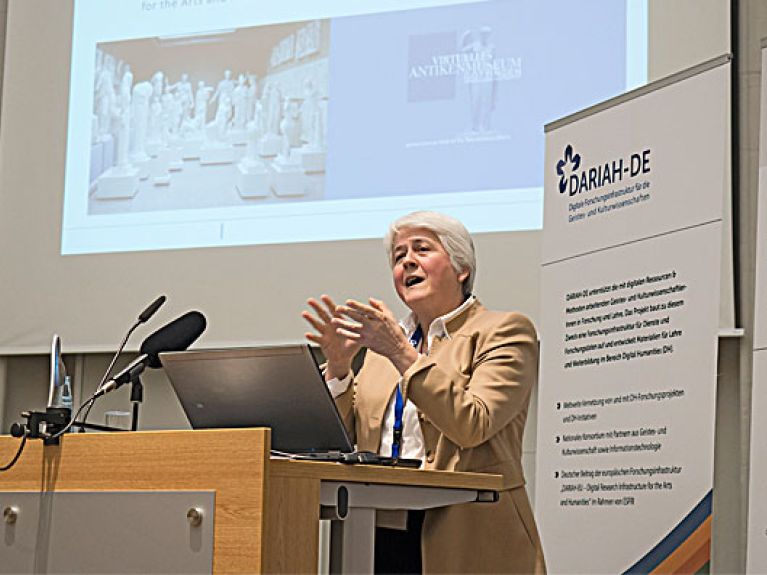Syria’s cultural heritage
Germany is involved at many levels in the preservation of Syria’s cultural heritage. The German Archaeological Institute (DAI) is playing a central role – an interview with its president, Professor Friederike Fless.

Professor Fless, armed conflicts are endangering Syria’s cultural heritage. What exactly do we mean when we refer to Syrian cultural heritage?
Syria’s cultural heritage is best described by giving the six UNESCO World Heritage sites as examples. They include the ancient cities of Damascus and Aleppo with their long histories, as well as the ancient city of Bosra. This city in the south of Syria is unparalleled with its unique ancient buildings made from basalt, the typical construction material used in this landscape on the Syrian-Jordanian border. But another landscape is also a World Heritage site: the limestone massif in the northwest of Syria. This area is also dominated by a characteristic building material, namely limestone. There are numerous ancient villages, buildings and churches that are still extremely well preserved today. The same can be said of the outstandingly preserved desert castles and important early mosques. The UNESCO World Heritage list also includes the Crusaders castles, such as the Crac des Chevaliers fortress, and the ancient oasis city of Palmyra. Significant early settlements, such as Ugarit, Mari and Ebla, have substantial archaeological finds dating from as early as the third century, and they are also on the list of places that should be named.
What is the greatest danger, and what is the current situation?
The dangers facing Syria’s cultural heritage are very varied. We can all vividly recall the targeted destruction carried out by Islamic State (IS). The destruction resulting from armed conflict can be seen everywhere, and it has reached incredible proportions. Then there are illegal digs as well. Estimates for 2015 suggest that out of some 740 archaeological sites, more than 200 have been destroyed by illegal excavations. In addition to this, because many residential buildings have been damaged or destroyed and there is a lack of building material, ancient buildings are increasingly being dismantled to acquire building material.
At an international conference for the protection of Syria’s cultural heritage, which took place at the Federal Foreign Office at the beginning of June 2016, comprehensive emergency measures were decided. What are they exactly?
UNESCO already passed an action plan for Syria in 2014. This has now been made more concrete. Very specific descriptions and implementation methods were made for the whole area of Syria concerning training and further training measures for cultural heritage protection and preservation, as well as for support through information and equipment. The first thing that needs to be done is to gather information from international research about recently destroyed buildings and historical monuments before any sensible decisions can be made about conservation and restoration issues. Then there is a need for know-how and measuring instruments, in order to document and assess damage and decide on the measures required for restoration and preservation. The Syrian colleagues who are endeavouring to preserve their country’s cultural heritage under extremely difficult conditions cannot do all this on their own. They need help.
Which role is Germany, or rather the German Archaeological Institute playing in this situation?
The German Archaeological Institute started working with the Museum of Islamic Art in Berlin early on in 2012 to digitize its archives. Meanwhile, we have managed to process more than 100,000 photos, plans and drawings concerning Syria. Of course, they are also available for our Syrian colleagues. The Syrian Heritage Archive Project is now being flanked by a project sponsored by the Archaeological Heritage Network entitled “Zero Hour – A future for the time after the crisis”. The basic aim of the project envisages building up capacities whilst planning for possible reconstruction work, not only in Syria but also in the areas of Iraq that have been affected by IS destruction. Specialists will be trained to carry out building documentations and damage assessments. At the same time they will be planning the necessary conservation and restoration measures. The ancient city of Aleppo, which is a UNESCO World Heritage site, has been made inhabitable again through work carried out since the 1990s by the German international cooperation organization GIZ. As a result, within the “Zero Hour” project the GIZ will be linking up with the rehabilitation of the ancient city of Aleppo. But experts will also be trained for other fields, such as museums and conservation.
Isn’t it difficult working in a crisis area?
The measures are mainly taking place in Syria’s neighbouring states and in Iraq. But it’s not only a matter of training experts. A key aim is to train Syrian refugees as craftsmen, especially stone masons, to qualify them for future reconstruction work. So the training and the creation of jobs for cultural preservation measures in Jordan, Turkey and Lebanon are also designed as humanitarian aid for refugees. For instance, by enabling them to work and train together with Lebanese and Jordanian people, the projects can help to reduce tensions in these countries. In addition to this, the German Academic Exchange Service (DAAD) is also included in the project. It is helping to support special study programmes for Syrian refugees in Cairo and Amman. The longer term perspective here is focussing on a “Leadership for Syria”. But these are just a few of the many facets included in the network. The “Zero Hour” project embraces far more aspects than I have been able to describe here. Over the next to three years the project is being funded by the Federal Foreign Office with 2.65 million euros each year.

